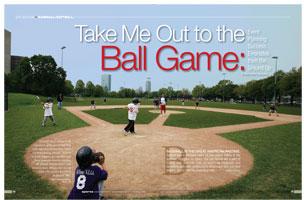
Baseball is the great American pastime. Softball was a medalist event for the United States at the summer Olympics for years. The two sports are a part of Spring and Summer, just as much as cookouts and vacations, with both continuing to attract new fans and new players, and to fuel the dreams of kids.
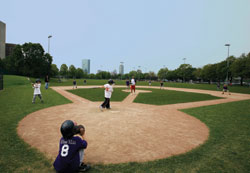 In the United States alone, 2.1 million children (boys and girls) participated in Little League last year. According to Chris Downs, Little League's media relations manager, enrollment in programs nationwide "has been pretty steady. We're up a little bit this year, though."
In the United States alone, 2.1 million children (boys and girls) participated in Little League last year. According to Chris Downs, Little League's media relations manager, enrollment in programs nationwide "has been pretty steady. We're up a little bit this year, though."
Little League, which starts at age five with Tee Ball and runs up to Big League (ages 16-18), includes its own World Series in eight divisions (four in softball and four in baseball). The locations for those games, said Downs, have not changed in several years. However, baseball camps and other events are offered independently in various locations nationwide, with Little League providing extensive resources to planners for these.
The interest in pitching, hitting and running continues as kids age. According to the National Federation of State High School Associations (NFHS), the service and administrative organization for high school sports, there are more student athletes than ever before; in fact, 7,429,381 high schoolers participated in some kind of sport during the 2007-2008 academic year, "an all-time high," according to Mary Struckhoff, an associate director at NFHS. Both baseball and softball made the top 10 in the organization's annual Sports Participation Summary. Among boys, baseball had 478,029 players in the last school year, while a total of 371,293 girls participated in fast-pitch softball.
With numbers like that, it's no mystery that players of all ages, from Little Leaguers to adults, and even senior citizens, are attending tournaments, camps and special events. If you're planning one of those events, you're naturally looking for the same thing the players are: a home run.
 The most important thing to remember, though, is that success starts from the ground up. No matter which sport, which age group or which skill level, all have one common denominator: a field. Before the first pitch is thrown, before the first fans buy their peanuts and Crackerjacks, before the first umpire is heckled, the diamond (and in fact the whole facility for baseball or softball) needs to be ready.
The most important thing to remember, though, is that success starts from the ground up. No matter which sport, which age group or which skill level, all have one common denominator: a field. Before the first pitch is thrown, before the first fans buy their peanuts and Crackerjacks, before the first umpire is heckled, the diamond (and in fact the whole facility for baseball or softball) needs to be ready.
First Things First
Regardless of whether your players are Little Leaguers or club-level athletes, you'll be looking for certain things.
"From what my clients tell me, and they are really the true authority here, the playing field is important in terms of dimensions and overall quality, but it's not the only important consideration," says Devin Conway, P.E. of Verde Design, Inc. in Santa Clara, CA. "Obviously it depends on what level of play we are addressing and what type of event is being considered, but there are key considerations to the event being held at your facility."
Define your needs: If you are planning to have multiple teams, with multiple games, contests or practices going on simultaneously, you'll need multiple fields. Facilities with lighting can extend the playing day and accommodate the extra innings, games or events.
Parking is critical: Whether your players arrive in a team bus, surrounded by an entourage and followed by clicking cameras, or whether they roll up in minivans driven by devoted parents,you'll need plenty of parking. Spectators, officials and team supporters, plus equipment managers (and depending upon the level of play, scouts appearing on behalf of schools or teams) will all want to be close to the facility.
Equipment needs: Bats, balls, shoes, gloves, uniforms, padding, face masks, helmets – baseball and softball players travel with plenty of equipment. All of it needs to be able to be stored safely, but within reach of each team. Should rain force a delay in the game, the storage location should be weatherproof.
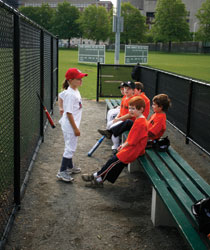 Seating: There should be bleachers for spectators, and benches, dugouts or other shelters for team members. Sure, parents and fans of really young children are used to showing up with folding chairs, but for a special event where larger crowds are expected, designated seating is essential. ADA considerations apply.
Seating: There should be bleachers for spectators, and benches, dugouts or other shelters for team members. Sure, parents and fans of really young children are used to showing up with folding chairs, but for a special event where larger crowds are expected, designated seating is essential. ADA considerations apply.
Conveniences: On-site rest rooms (or portable toilets and hand sanitizing stations) are necessary. Refreshment stands are important too. Booths for souvenir sales will allow teams to fundraise.
Amenities: As previously mentioned, lighting for baseball and softball fields can allow for night play. (Note: Different levels of ball require different levels of light). Public areas, such as those near rest rooms and concessions, should also be well-lit to promote safety. A public address system is necessary, as is a score board.
Emergency Facilities: If the venue does not have a first-aid tent or office, it must be accessible to emergency personnel.
Media-Friendly: Want newspaper, radio and/or TV coverage? Look for a facility that has a working press box with all the extras: electricity, phones and Wi-Fi.
What's Fun? Camps and tournaments should be accessible to attractions that players and others can take advantage of during downtime. For example, of interest to youth might be areas with restaurants, malls and tourist attractions like mini-golf, theme parks or water parks.
Game Time
On the Surface: Once you begin to investigate the facilities available in a given area, you will be confronted with the choice of those with natural grass, or those with synthetic turf. Multiple scientific studies have been conducted with regard to the safety of each surface, and the rate of injuries sustained by players.
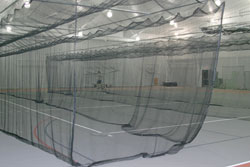 The American Sports Builders Association (ASBA), the national organization for designers, builders and suppliers of materials for athletic facilities, has no official commitment on which surface should be considered safer, and advises event planners of sports events to consult the managers of the facilities themselves, the governing body of the sport being played, or the manufacturers of the specific surface used, to make an informed decision.
The American Sports Builders Association (ASBA), the national organization for designers, builders and suppliers of materials for athletic facilities, has no official commitment on which surface should be considered safer, and advises event planners of sports events to consult the managers of the facilities themselves, the governing body of the sport being played, or the manufacturers of the specific surface used, to make an informed decision.
Whichever surface is chosen, it must be kept in shape. Baseball and softball fields are the only commonly used sports facilities that include both grass and exposed soil (usually a commercially available compound) in the same space. Dan Wright of Sports Turf Company, Inc. in Blacksburg, Georgia, notes that typically for ball park owners, "the selection of the surface to be used,whether natural grass (native soil, with amendments or sand-based) or synthetic turf is predicated on budget available."
A natural turf field stays fresh with ongoing weeding, fertilization and mowing. An artificial turf facility should be cleaned, groomed and sanitized on a regular basis. Both fields will need to have adequate water drainage to ensure playability. Bases should be kept clean and playing lines clearly marked.
Diamonds: The facility you choose should be right for the teams you're hosting. Baseball and softball diamonds do vary in terms of size, according to the level of play. Within Little League play, for example, there are various divisions. Most players below the age of 13 use a 60' diamond (meaning that there is a distance of 60' between each base,with a pitching distance (the distance between the pitcher's mound and home plate) of 46'. (As a side note, the term ‘Little League' is often mistakenly used to refer to any youth baseball team; however, only those affiliated with the national Little League organization are Little League teams).
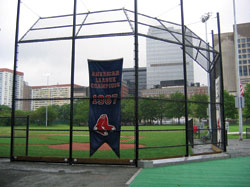 As children age and move on to other Little League divisions, playing dimensions increase. For example, at age 13-14, players are using a standard 90' diamond, with a pitching distance of 60', 6". These dimensions will apply to high-school-level play (as governed by the NFHS) college-level baseball (governed by the National Collegiate Athletic Association, or NCAA), and to Major League Baseball (MLB).
As children age and move on to other Little League divisions, playing dimensions increase. For example, at age 13-14, players are using a standard 90' diamond, with a pitching distance of 60', 6". These dimensions will apply to high-school-level play (as governed by the NFHS) college-level baseball (governed by the National Collegiate Athletic Association, or NCAA), and to Major League Baseball (MLB).
Softball dimensions and rules (youth and adult, fast-pitch and slow-pitch) also vary from those of baseball. In addition, other leagues (Pony League, Babe Ruth League, etc.) will also have their own guidelines, and the outfield measurements will differ for various sports and leagues. Contact the appropriate governing body for the event that is to take place. (See the shaded box in this article for contact information. Because rules can change from year to year, the most updated version should be obtained prior to an event.)
On the Fence: Fencing around ball parks keeps unwanted foot traffic off the field and defines the boundaries to players. According to the Major League Baseball (MLB) website, the average height of outfield fencing is eight feet; however, four- to six- foot fencing is often used on recreational fields. For higher levels of play, the top edge of the fence may be padded with three inches of foam(or capped with a commercially made product) to help ensure safety of players who want to attempt challenging plays.
In the Background: The backstop (the wing-like fence structure behind home plate) protects spectators and others from flying balls and tossed bats. It can be made of chain link fencing or of nets and cables, depending upon the level of play involved. It too has specific required dimensions.
Officials: Game officials should be well versed in the rules for the sports, league, governing body and age group for the specific event. The local high school athletic association, Little League section, etc., can help point you in the correct direction. For an event being held during a busy sports season, officials' time may need to be reserved in advance.
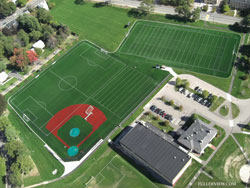 Equipment: Sports camps, all-star tourneys and other events can require more equipment, and sometimes more sophisticated equipment, than any one facility has on hand. Needed will be items like batting cages, tee-ball equipment, radar guns (for measuring pitch speed), electronic pitch counters and more. Some equipment can be rented, but schools, rec programs or other organizations in the area may have equipment they can loan to the chosen facility.
Equipment: Sports camps, all-star tourneys and other events can require more equipment, and sometimes more sophisticated equipment, than any one facility has on hand. Needed will be items like batting cages, tee-ball equipment, radar guns (for measuring pitch speed), electronic pitch counters and more. Some equipment can be rented, but schools, rec programs or other organizations in the area may have equipment they can loan to the chosen facility.
Ask for advice: Local athletic associations can provide guidance regarding the various competition and recreational sports facilities in the area. Just as important, they may have insights on state-specific rules; for example, said Stuckhoff, some states' high school athletic associations prohibit their players from participating in tournaments more than a certain distance from their home state.
There's a lot that goes on before the words "Play ball!" are ever heard. Make sure that you've covered all your bases.

